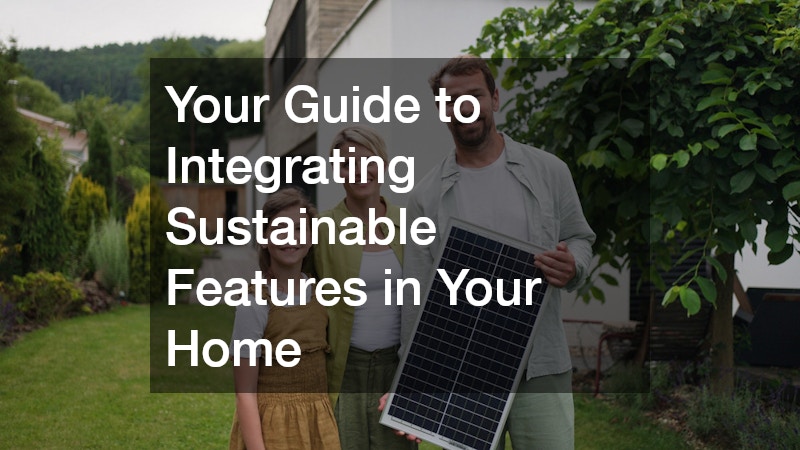Sustainability is no longer a fringe concept. It’s quickly becoming a necessity for responsible homeowners. As more people grow aware of environmental issues and their impact on the planet, interest in eco-conscious living is rising. One of the most significant places where change can begin is right at home. Whether you’re building new or improving existing spaces, integrating sustainable features into your home can help reduce your carbon footprint, lower your energy bills, and create a healthier environment for your family.
In this guide, we’ll explore a range of approaches for making your home more environmentally friendly. From small-scale adjustments to large renovations, each step can play a part in building a greener future. You’ll find that some changes are as simple as adopting energy-efficient appliances or installing better windows, while others might require a deeper dive into planning and construction practices. Regardless of the route, the result is a more efficient and thoughtful way to live.
The journey to a greener home doesn’t have to be overwhelming. It’s about making intentional, informed decisions that support both your lifestyle and the planet. Let’s walk through how to bring sustainable features into your living space in ways that are both effective and attainable.
1. Smaller Homes, Bigger Wins

The trend toward smaller living spaces is about more than just minimalism—it’s about maximizing efficiency and reducing environmental impact. By opting for a compact footprint, homeowners can lower energy consumption, limit material use, and simplify their lifestyles. Living in a smaller space encourages thoughtful design and the inclusion of only what is truly necessary, which naturally supports the incorporation of sustainable features. It’s not just about saving space; it’s about saving resources.
Tiny house builders specialize in designing and building small homes and have become leaders in environmentally conscious design. Many tiny homes incorporate solar panels, composting toilets, and efficient insulation as standard features, helping homeowners reduce their reliance on traditional utilities and making green living more accessible.
Furthermore, the appeal of smaller homes goes beyond environmental concerns—they also promote financial freedom and a simpler lifestyle. When sustainable features are integrated into these compact spaces, the result is a holistic living solution that addresses both ecological and personal well-being. This makes smaller living not just a trend but a deliberate and forward-thinking choice for those who want to align their homes with their values.
2. Sustainable Upgrades
Home improvement projects are an ideal opportunity to reassess your home’s environmental impact. Sustainable upgrades not only benefit the planet but also improve the efficiency and comfort of your living space. With smart planning, even moderate renovations can include meaningful, sustainable features.
The remodeling process often involves significant decisions around materials, layout, and functionality. Choosing non-toxic paints, reclaimed wood, and energy-efficient fixtures can greatly reduce your renovation’s environmental footprint. Additionally, upgrading insulation, windows, and heating/cooling systems can make your home more energy-efficient in the long run. Each choice made during remodeling either contributes to or detracts from sustainability, so it’s worth planning carefully with green goals in mind.
The impact of these decisions multiplies over time, both in cost savings and environmental benefits. Sustainable features incorporated during remodeling don’t just make your home more efficient—they also increase property value and future-proof your investment. Renovating with a green mindset transforms your house into a more resilient, efficient, and responsible space for years to come.
3. Choosing Green Pros

The professionals you choose to work with can make a huge difference in the outcome of your eco-friendly home projects. A good contractor not only ensures high-quality work but also helps you identify opportunities to improve sustainability throughout your project. From selecting materials to managing waste, experienced professionals bring knowledge that can enhance your home with lasting, sustainable features.
When hiring a remodeling contractor, it’s worth seeking someone with a background in green building practices. These contractors understand how to source eco-friendly materials, suggest efficient designs, and implement strategies that reduce energy consumption and environmental waste. Some may also be certified in sustainable construction standards, offering additional assurance that your project will align with your environmental goals.
Beyond just construction skills, a contractor focused on sustainability becomes a valuable partner in long-term planning. They can advise on maintenance practices, help future-proof systems, and connect you with other green-minded professionals. Choosing someone aligned with your vision ensures that sustainable features aren’t an afterthought—they become a core part of your home’s identity from the very beginning.
4. Eco-Friendly Bathrooms
Bathrooms may be some of the smallest rooms in a home, but they can have a surprisingly large environmental impact. Between water usage, ventilation needs, and material selection, the bathroom presents many opportunities for going green. Integrating sustainable features into a bathroom renovation can help reduce water waste, improve energy efficiency, and create a healthier space with better air quality and non-toxic materials.
Partnering with a knowledgeable bath remodeler can make a significant difference in your eco-friendly goals. These professionals can recommend low-flow fixtures, water-saving toilets, and sustainable materials like recycled tile or responsibly sourced wood. They also understand how to maximize space and ventilation in ways that support both comfort and energy efficiency. With their expertise, it becomes much easier to align your remodel with sustainable values.
Incorporating green choices into your bathroom doesn’t require sacrificing style or comfort. Sustainable features often enhance the spa-like feel many homeowners seek. Heated floors with energy-efficient systems, moisture-resistant paints with low VOCs, and reclaimed vanities can elevate the space while reducing your environmental impact.
5. Greener Kitchens

The kitchen is the heart of the home and one of the highest energy-consuming rooms. It’s where electricity, water, gas, and appliances all come together, making it a prime candidate for eco-conscious upgrades. A thoughtfully planned kitchen renovation offers the opportunity to incorporate sustainable features that improve efficiency and minimize your carbon footprint.
A strategic kitchen remodel can dramatically reduce energy and water usage. Upgrading to Energy Star appliances, installing LED lighting, and choosing sustainable cabinetry materials are all impactful steps. Even countertop materials like recycled glass or composite stone can contribute to an environmentally responsible space. Proper layout planning can also enhance natural light and reduce reliance on artificial sources.
Beyond appliances and finishes, sustainability in the kitchen also includes waste reduction strategies. Consider incorporating built-in composting solutions, better storage for bulk foods, and efficient recycling systems. These details might seem small, but they contribute to a kitchen that supports a greener lifestyle every day. With the right approach, the kitchen becomes not just a place to cook, but a hub for living more sustainably.
6. Better Home Lighting
Lighting plays a vital role in energy use, comfort, and aesthetics. Natural light reduces the need for artificial lighting, improves mood, and helps regulate indoor temperatures. A smart approach to lighting starts with design and continues through careful selection of windows and fixtures that contribute to your home’s sustainable features.
One of the most effective ways to enhance natural lighting is through window replacement. Older windows often leak air and fail to maximize light or insulation. Newer models are designed with energy efficiency in mind, using double or triple panes, UV coatings, and framing materials that improve performance. This not only brings more natural light into your home but also helps maintain interior temperatures with less energy use.
Maximizing daylight and minimizing energy waste is a core principle of sustainable home design. With better window placement, energy-efficient models, and thoughtful orientation, homeowners can reduce reliance on electricity while improving indoor environments. These upgrades create a more comfortable, efficient, and eco-conscious space you’ll enjoy for years.
7. Building Waste Less

Home improvement and new construction projects can produce a surprising amount of waste. From packaging to excess materials, much of what’s discarded could be reused or recycled. Embracing a mindset of minimal waste during building or renovation phases is essential to reducing the environmental burden of home development. Incorporating sustainable features means you are mindful about how you build and dispose of waste.
A key part of minimizing waste is committing to construction recycling throughout the project. By sorting and diverting wood, drywall, concrete, and metals away from landfills, homeowners and contractors can significantly reduce the environmental impact of their build. Some materials can be reused on-site, while others can be sent to specialized facilities that process and reintegrate them into future construction projects.
The benefit of a well-planned recycling strategy goes beyond environmental responsibility. It can also lower disposal costs, support local recycling businesses, and provide transparency in the home’s sustainability story. Aligning building processes with sustainable features starts at the demolition and planning stages—and continues through every phase until the final nail is driven.
8. Reclaiming Materials
Choosing where your building materials come from is just as important as where they go. Reclaimed and recycled materials can provide the same durability and beauty as new ones, often with even more character. Using salvaged materials reduces the demand for new resources and keeps useful items out of landfills. This practice adds an extra layer of eco-consciousness when integrating sustainable features into your home.
A scrap recycling business plays a critical role in this cycle by providing access to recovered materials from other buildings, deconstructions, or industrial sources. These businesses collect, process, and resell metal, wood, stone, and other components that would otherwise go to waste. Homeowners looking to renovate sustainably can find everything from vintage doors to reclaimed lumber and copper fixtures through these suppliers.
Reclaimed materials also contribute to a unique design aesthetic, adding warmth, texture, and history to a space. When integrated properly, these elements enhance both the style and sustainability of your home. Using repurposed items from a scrap recycling business reduces consumption, conserves resources, and allows sustainable features to shine through in truly original ways.
9. Clean Energy Options
Energy efficiency is at the core of eco-friendly home design. While many homeowners consider solar power, other renewable systems offer long-term savings and environmental benefits. One of the most powerful is geothermal energy, which uses the consistent temperature below the Earth’s surface to heat and cool your home. When integrated with other sustainable features, it creates an incredibly efficient and low-impact home environment.
A geothermal system works by circulating a fluid through pipes underground, which absorbs or dissipates heat depending on the season. Geothermal systems use the earth’s stable temperature, making them one of the most sustainable and cost-effective heating and cooling solutions available. The initial investment can be significant, but the long-term savings on utility bills and reduced environmental impact are well worth it.
Incorporating geothermal into your home design enhances energy independence and drastically reduces your carbon footprint. It pairs well with other sustainable features such as solar panels, energy-efficient insulation, and smart thermostats. With no visible units or noise pollution, it’s also a discreet and low-maintenance solution that aligns beautifully with a modern, green lifestyle.
10. Eco-Minded Roof Design
The roof is one of the most influential components in a home’s environmental performance. From solar reflectivity to insulation, a well-designed roof can reduce energy use and support a healthier living space. It also plays a crucial role in stormwater management, ventilation, and solar panel integration. That’s why it’s essential to approach roof design with sustainability in mind and include relevant sustainable features.
Working with experienced roofers ensures that your roofing project balances durability, performance, and eco-friendliness. These professionals can help you select materials like metal, recycled shingles, or living roofs that reflect sunlight and reduce heat absorption. Additionally, roofers understand how to improve insulation and airflow, which are vital to energy efficiency and comfort.
A sustainably designed roof supports the broader environmental goals of your home. Whether you’re looking to lower energy bills, add solar capabilities, or prevent heat loss, your roof is a primary player. By collaborating with skilled roofers and selecting smart materials, you can ensure this part of your home contributes meaningfully to your green living goals.
A Blueprint for Green Living
As you begin or continue your journey toward a more environmentally conscious home, it’s essential to view each renovation or building choice through the lens of sustainability. Whether you’re updating a single room or designing a house from the ground up, each decision contributes to the overall impact your living space has on the planet. From energy to materials, light to layout, these choices add up over time to shape a home that is not only efficient but also harmonious with the natural world.
What ties all these ideas together is the implementation of sustainable features. These thoughtfully selected elements reduce environmental harm, improve quality of life, and prepare your home for the future. They’re essential strategies for building a healthier, more resilient lifestyle. With help from experienced professionals, from remodelers to energy experts, every homeowner can take steps to make their home more sustainable.
Your home should reflect your values, and today, more than ever, those values include stewardship of the earth and mindfulness about resource use. Whether your changes are large or small, integrating sustainable features ensures your home is a place of care, innovation, and lasting value.




